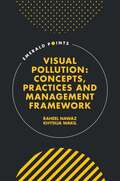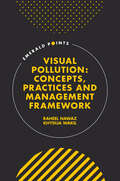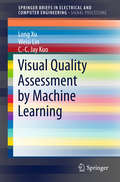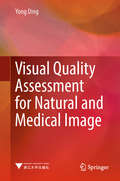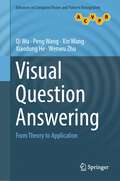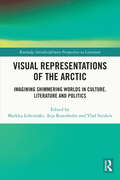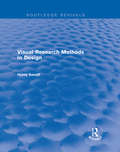- Table View
- List View
Visual Pattern Discovery and Recognition (SpringerBriefs in Computer Science)
by Hongxing Wang Chaoqun Weng Junsong YuanThis book presents a systematic study of visual pattern discovery, from unsupervised to semi-supervised manner approaches, and from dealing with a single feature to multiple types of features. Furthermore, it discusses the potential applications of discovering visual patterns for visual data analytics, including visual search, object and scene recognition. It is intended as a reference book for advanced undergraduates or postgraduate students who are interested in visual data analytics, enabling them to quickly access the research world and acquire a systematic methodology rather than a few isolated techniques to analyze visual data with large variations. It is also inspiring for researchers working in computer vision and pattern recognition fields. Basic knowledge of linear algebra, computer vision and pattern recognition would be helpful to readers.
Visual Peace: Images, Spectatorship, and the Politics of Violence (Rethinking Peace and Conflict Studies)
by Frank MöllerThis book introduces a new research agenda for visual peace research, providing a political analysis of the relationship between visual representations and the politics of violence nationally and internationally. Using a range of genres, from photography to painting, it elaborates on how people can become agents of their own image.
Visual Perception for Humanoid Robots: Environmental Recognition and Localization, from Sensor Signals to Reliable 6D Poses (Cognitive Systems Monographs #38)
by David Israel González AguirreThis book provides an overview of model-based environmental visual perception for humanoid robots. The visual perception of a humanoid robot creates a bidirectional bridge connecting sensor signals with internal representations of environmental objects. The objective of such perception systems is to answer two fundamental questions: What & where is it? To answer these questions using a sensor-to-representation bridge, coordinated processes are conducted to extract and exploit cues matching robot’s mental representations to physical entities. These include sensor & actuator modeling, calibration, filtering, and feature extraction for state estimation. This book discusses the following topics in depth: • Active Sensing: Robust probabilistic methods for optimal, high dynamic range image acquisition are suitable for use with inexpensive cameras. This enables ideal sensing in arbitrary environmental conditions encountered in human-centric spaces. The book quantitatively shows the importance of equipping robots with dependable visual sensing. • Feature Extraction & Recognition: Parameter-free, edge extraction methods based on structural graphs enable the representation of geometric primitives effectively and efficiently. This is done by eccentricity segmentation providing excellent recognition even on noisy & low-resolution images. Stereoscopic vision, Euclidean metric and graph-shape descriptors are shown to be powerful mechanisms for difficult recognition tasks. • Global Self-Localization & Depth Uncertainty Learning: Simultaneous feature matching for global localization and 6D self-pose estimation are addressed by a novel geometric and probabilistic concept using intersection of Gaussian spheres. The path from intuition to the closed-form optimal solution determining the robot location is described, including a supervised learning method for uncertainty depth modeling based on extensive ground-truth training data from a motion capture system.The methods and experiments are presented in self-contained chapters with comparisons and the state of the art. The algorithms were implemented and empirically evaluated on two humanoid robots: ARMAR III-A & B. The excellent robustness, performance and derived results received an award at the IEEE conference on humanoid robots and the contributions have been utilized for numerous visual manipulation tasks with demonstration at distinguished venues such as ICRA, CeBIT, IAS, and Automatica.
Visual Perception for Manipulation and Imitation in Humanoid Robots (Cognitive Systems Monographs #4)
by Pedram AzadVisual Perception from a Computer Graphics Perspective
by William Thompson Roland Fleming Sarah Creem-Regehr Jeanine Kelly StefanucciThis book provides an introduction to human visual perception suitable for readers studying or working in the fields of computer graphics and visualization, cognitive science, and visual neuroscience. It focuses on how computer graphics images are generated, rather than solely on the organization of the visual system itself; therefore, the text pro
Visual Politics of Psychoanalysis: Art and the Image in Post-Traumatic Cultures
by Griselda PollockIn this innovative collection, a distinguished group of international authors dare to think psychoanalytically about the legacies of political violence and suffering in relation to post-traumatic cultures worldwide. They build on maverick art historian Aby Warburg's project of combining social, cultural, anthropological and psychological analyses of the image in order to track the undercurrents of cultural violence in the representational repertoire of Western modernity. Drawing on post-colonial and feminist theory, they analyze the image and the aesthetic in conditions of historical trauma, from enslavement and colonization to the Irish Famine, from Denmark's national trauma about migrants and cartoons to collective shock after 9/11, from individual traumas of loss registered in allegory to newsreels and documentaries on suicide bombing in Israel/Palestine, and from Kristeva's novels to Kathryn Bigelow's cinema.
Visual Politics of Psychoanalysis: Art and the Image in Post-Traumatic Cultures (New Encounters: Arts, Cultures, Concepts)
by Griselda PollockIn this innovative collection, a distinguished group of international authors dare to think psychoanalytically about the legacies of political violence and suffering in relation to post-traumatic cultures worldwide. They build on maverick art historian Aby Warburg's project of combining social, cultural, anthropological and psychological analyses of the image in order to track the undercurrents of cultural violence in the representational repertoire of Western modernity. Drawing on post-colonial and feminist theory, they analyze the image and the aesthetic in conditions of historical trauma, from enslavement and colonization to the Irish Famine, from Denmark's national trauma about migrants and cartoons to collective shock after 9/11, from individual traumas of loss registered in allegory to newsreels and documentaries on suicide bombing in Israel/Palestine, and from Kristeva's novels to Kathryn Bigelow's cinema.
Visual Pollution: Concepts, Practices and Management Framework (Emerald Points)
by Raheel Nawaz Khydija WakilVisual pollution is an emerging, multi-dimensional, subjective, and under studied area of manmade environments that has recently received researchers' focus. Visual Pollution: Concepts, Practices and Management Framework offers the first substantial cutting-edge exploration of visual pollution in urban settlements, uncovering the conceptualisation, geography-specific visual pollutants, methods of visual pollution assessment and management frameworks. Nawaz and Wakil dive into the contrasting prevalence of visual pollution geographically and the connection of human behaviour with urban aesthetics, urban management, measurement tools, information systems and regulatory frameworks. This novel contribution fills the international knowledge gap to generate dynamic and practical solutions for the mitigation in regulatory and enforcement frames. Providing a holistic picture to a diverse multi-dimensional readership interested to explore the phenomena of visual pollution, Visual Pollution: Concepts, Practices and Management Framework is an essential read for those working and researching in the fields of urban design, property management, planning, building, and policymakers confronted with a rapidly urbanising planet.
Visual Pollution: Concepts, Practices and Management Framework (Emerald Points)
by Raheel Nawaz Khydija WakilVisual pollution is an emerging, multi-dimensional, subjective, and under studied area of manmade environments that has recently received researchers' focus. Visual Pollution: Concepts, Practices and Management Framework offers the first substantial cutting-edge exploration of visual pollution in urban settlements, uncovering the conceptualisation, geography-specific visual pollutants, methods of visual pollution assessment and management frameworks. Nawaz and Wakil dive into the contrasting prevalence of visual pollution geographically and the connection of human behaviour with urban aesthetics, urban management, measurement tools, information systems and regulatory frameworks. This novel contribution fills the international knowledge gap to generate dynamic and practical solutions for the mitigation in regulatory and enforcement frames. Providing a holistic picture to a diverse multi-dimensional readership interested to explore the phenomena of visual pollution, Visual Pollution: Concepts, Practices and Management Framework is an essential read for those working and researching in the fields of urban design, property management, planning, building, and policymakers confronted with a rapidly urbanising planet.
Visual Quality Assessment by Machine Learning (SpringerBriefs in Electrical and Computer Engineering)
by Long Xu Weisi Lin C.-C. Jay KuoThe book encompasses the state-of-the-art visual quality assessment (VQA) and learning based visual quality assessment (LB-VQA) by providing a comprehensive overview of the existing relevant methods. It delivers the readers the basic knowledge, systematic overview and new development of VQA. It also encompasses the preliminary knowledge of Machine Learning (ML) to VQA tasks and newly developed ML techniques for the purpose. Hence, firstly, it is particularly helpful to the beginner-readers (including research students) to enter into VQA field in general and LB-VQA one in particular. Secondly, new development in VQA and LB-VQA particularly are detailed in this book, which will give peer researchers and engineers new insights in VQA.
Visual Quality Assessment for Natural and Medical Image
by Yong DingImage quality assessment (IQA) is an essential technique in the design of modern, large-scale image and video processing systems. This book introduces and discusses in detail topics related to IQA, including the basic principles of subjective and objective experiments, biological evidence for image quality perception, and recent research developments. In line with recent trends in imaging techniques and to explain the application-specific utilization, it particularly focuses on IQA for stereoscopic (3D) images and medical images, rather than on planar (2D) natural images. In addition, a wealth of vivid, specific figures and formulas help readers deepen their understanding of fundamental and new applications for image quality assessment technology. This book is suitable for researchers, clinicians and engineers as well as students working in related disciplines, including imaging, displaying, image processing, and storage and transmission. By reviewing and presenting the latest advances, and new trends and challenges in the field, it benefits researchers and industrial R&D engineers seeking to implement image quality assessment systems for specific applications or design/optimize image/video processing algorithms.
Visual Question Answering: From Theory to Application (Advances in Computer Vision and Pattern Recognition)
by Qi Wu Peng Wang Xin Wang Xiaodong He Wenwu ZhuVisual Question Answering (VQA) usually combines visual inputs like image and video with a natural language question concerning the input and generates a natural language answer as the output. This is by nature a multi-disciplinary research problem, involving computer vision (CV), natural language processing (NLP), knowledge representation and reasoning (KR), etc. Further, VQA is an ambitious undertaking, as it must overcome the challenges of general image understanding and the question-answering task, as well as the difficulties entailed by using large-scale databases with mixed-quality inputs. However, with the advent of deep learning (DL) and driven by the existence of advanced techniques in both CV and NLP and the availability of relevant large-scale datasets, we have recently seen enormous strides in VQA, with more systems and promising results emerging. This book provides a comprehensive overview of VQA, covering fundamental theories, models, datasets, and promising future directions. Given its scope, it can be used as a textbook on computer vision and natural language processing, especially for researchers and students in the area of visual question answering. It also highlights the key models used in VQA.
Visual Redress in Africa from Indigenous and New Materialist Perspectives (Routledge Research in Art and Politics)
by Gera De VilliersThrough an indigenous and new materialist thinking approach, this book discusses various examples in Africa where colonial public art, statues, signs and buildings were removed or changed after countries’ independence. An African perspective on these processes will bring new understandings and assist in finding ways to address issues in other countries and continents. These often-unresolved issues attract much attention, but finding ways of working through them requires a deeper and broader approach. Contributors propose an African indigenous knowledge perspective in relation to new materialism as alternative approaches to engage with visual redress and decolonisation of spaces in an African context. Authors such as Frantz Fanon, Ngugi Wa Thiong’o and George Dei will be referred to regarding indigenous knowledge, decolonialisation and Africanisation, and Karen Barad, Donna Haraway and Rosi Braidotti regarding new materialism. The book will be of interest to scholars working in art history, visual culture, heritage studies, African studies and architecture.
Visual Redress in Africa from Indigenous and New Materialist Perspectives (Routledge Research in Art and Politics)
Through an indigenous and new materialist thinking approach, this book discusses various examples in Africa where colonial public art, statues, signs and buildings were removed or changed after countries’ independence. An African perspective on these processes will bring new understandings and assist in finding ways to address issues in other countries and continents. These often-unresolved issues attract much attention, but finding ways of working through them requires a deeper and broader approach. Contributors propose an African indigenous knowledge perspective in relation to new materialism as alternative approaches to engage with visual redress and decolonisation of spaces in an African context. Authors such as Frantz Fanon, Ngugi Wa Thiong’o and George Dei will be referred to regarding indigenous knowledge, decolonialisation and Africanisation, and Karen Barad, Donna Haraway and Rosi Braidotti regarding new materialism. The book will be of interest to scholars working in art history, visual culture, heritage studies, African studies and architecture.
Visual Representations and Interpretations
by Ray Paton Irene NeilsenThe value of multi-disciplinary research and the exchange of ideas and methods across traditional discipline boundaries are well recognised. Indeed, it could be justifiably argued that many of the advances in science and engineering take place because the ideas, methods and the tools of thought from one discipline become re applied in others. Sadly, it is also the case that many subject areas develop specialised vocabularies and concepts and can consequently approach more general problems in fairly narrow, subject-specific ways. Consequently barriers develop between disciplines that prevent the free flow of ideas and the collaborations that on Visual Representations could often bring success. VRI'98, a workshop focused & Interpretations, was intended to break down such barriers. The workshop was held in the Foresight Conference Centre, which occupies part of the former Liverpool Royal Infirmary, a Grade 2 listed building, which has been recently restored. The building combines a majestic architecture with the latest in new conference facilities and technologies and thus provided a very suitable setting for a workshop aimed at bringing the Arts and the Sciences together. of the workshop was to promote inter-disciplinary awareness across The main aim a range of disciplines where visual representations and interpretations are exploited. Contributions to the workshop were therefore invited from researchers who are actively investigating visual representations and interpretations: - artists, architects, biologists, chemists, clinicians, cognitive scientists, computer scientists, educationalists, engineers, graphic designers, linguists, mathematicians, philosophers, physicists, psychologists and social scientists.
Visual Representations of the Arctic: Imagining Shimmering Worlds in Culture, Literature and Politics (Routledge Interdisciplinary Perspectives on Literature)
by Markku Lehtimäki Arja Rosenholm Vlad StrukovPrivileging the visual as the main method of communication and meaning-making, this book responds critically to the worldwide discussion about the Arctic and the North, addressing the interrelated issues of climate change, ethics and geopolitics. A multi-disciplinary, multi-modal exploration of the Arctic, it supplies an original conceptualization of the Arctic as a visual world encompassing an array of representations, imaginings, and constructions. By examining a broad range of visual forms, media and forms such as art, film, graphic novels, maps, media, and photography, the book advances current debates about visual culture. The book enriches contemporary theories of the visual taking the Arctic as a spatial entity and also as a mode of exploring contemporary and historical visual practices, including imaginary constructions of the North. Original contributions include case studies from all the countries along the Arctic shore, with Russian material occupying a large section due to the country’s impact on the region
Visual Representations of the Arctic: Imagining Shimmering Worlds in Culture, Literature and Politics (Routledge Interdisciplinary Perspectives on Literature)
by Markku Lehtimäki Arja Rosenholm Vlad StrukovPrivileging the visual as the main method of communication and meaning-making, this book responds critically to the worldwide discussion about the Arctic and the North, addressing the interrelated issues of climate change, ethics and geopolitics. A multi-disciplinary, multi-modal exploration of the Arctic, it supplies an original conceptualization of the Arctic as a visual world encompassing an array of representations, imaginings, and constructions. By examining a broad range of visual forms, media and forms such as art, film, graphic novels, maps, media, and photography, the book advances current debates about visual culture. The book enriches contemporary theories of the visual taking the Arctic as a spatial entity and also as a mode of exploring contemporary and historical visual practices, including imaginary constructions of the North. Original contributions include case studies from all the countries along the Arctic shore, with Russian material occupying a large section due to the country’s impact on the region
Visual Representations of the Cold War and Postcolonial Struggles: Art in East and Southeast Asia (The Cold War in Asia)
by Midori Yamamura Yu-Chieh LiThe essays and artworks gathered in this volume examine the visual manifestations of postcolonial struggles in art in East and Southeast Asia, as the world transitioned from the communist/capitalist ideological divide into the new global power structure under neoliberalism that started taking shape during the Cold War. The contributors to this volume investigate the visual art that emerged in Australia, China, Cambodia, Indonesia, Korea, Okinawa, and the Philippines. With their critical views and new approaches, the scholars and curators examine how visual art from postcolonial countries deviated from the communist/capitalist dichotomy to explore issues of identity, environment, rapid commercialization of art, and independence. These foci offer windows into some lesser-known aspects of the Cold War, including humanistic responses to the neo-imperial exploitations of people and resources as capitalism transformed into its most aggressive form. Given its unique approach, this seminal study will be of great value to scholars of 20th-century East Asian and Southeast Asian art history and visual and cultural studies.
Visual Representations of the Cold War and Postcolonial Struggles: Art in East and Southeast Asia (The Cold War in Asia)
by Midori Yamamura Yu-Chieh LiThe essays and artworks gathered in this volume examine the visual manifestations of postcolonial struggles in art in East and Southeast Asia, as the world transitioned from the communist/capitalist ideological divide into the new global power structure under neoliberalism that started taking shape during the Cold War. The contributors to this volume investigate the visual art that emerged in Australia, China, Cambodia, Indonesia, Korea, Okinawa, and the Philippines. With their critical views and new approaches, the scholars and curators examine how visual art from postcolonial countries deviated from the communist/capitalist dichotomy to explore issues of identity, environment, rapid commercialization of art, and independence. These foci offer windows into some lesser-known aspects of the Cold War, including humanistic responses to the neo-imperial exploitations of people and resources as capitalism transformed into its most aggressive form. Given its unique approach, this seminal study will be of great value to scholars of 20th-century East Asian and Southeast Asian art history and visual and cultural studies.
Visual Research: An Introduction to Research Methods in Graphic Design
by Russell Bestley Paul McNeilPacked with more than 200 colour illustrations, Visual Research explores a range of research methods that can be used by graphic designers and visual communicators in the development of clear and purposeful design solutions. The book introduces key terms and theories that underlie design research; examining the importance of visual grammar and design literacy, audience, communication theory and semiotics.Each chapter features case studies, many new to this edition, that demonstrate how the use of research methods can form the basis of effective visual communication and design problem solving, eschewing end-product analysis for a discussion of the way research feeds into the design process.With new case studies from Matt Cooke, Colette Sadlier and many others, this new edition also brings together all of the 'Key Concept' features and content from previous editions into their own distinct chapter, making it easier for readers to discover design-led tools and information design methods, for both print and on-screen design.
Visual Research: An Introduction to Research Methods in Graphic Design
by Russell Bestley Paul McNeilPacked with more than 200 colour illustrations, Visual Research explores a range of research methods that can be used by graphic designers and visual communicators in the development of clear and purposeful design solutions. The book introduces key terms and theories that underlie design research; examining the importance of visual grammar and design literacy, audience, communication theory and semiotics.Each chapter features case studies, many new to this edition, that demonstrate how the use of research methods can form the basis of effective visual communication and design problem solving, eschewing end-product analysis for a discussion of the way research feeds into the design process.With new case studies from Matt Cooke, Colette Sadlier and many others, this new edition also brings together all of the 'Key Concept' features and content from previous editions into their own distinct chapter, making it easier for readers to discover design-led tools and information design methods, for both print and on-screen design.
Visual Research: An Introduction to Research Methods in Graphic Design (Required Reading Range Ser.)
by Russell Bestley Ian NoblePacked with more than 200 colour illustrations, Visual Research explores a range of research methods that can be used by graphic designers and visual communicators in the development of clear and purposeful design solutions. The book introduces key terms and theories that underlie design research; examining the importance of visual grammar and design literacy, audience, communication theory and semiotics. Each chapter features case studies that demonstrate how the use of research methods can form the basis of effective visual communication and design problem solving, eschewing end product analysis for a discussion of the way research feeds into the design process. The third edition features new case studies in each chapter, updated design exercises and a new chapter on design-led tools and information design methods, in relation to both print and on-screen design.
Visual Research Methods in Design (Routledge Revivals)
by Henry SanoffFirst published in 1991, this book is about applications and issues relating to the visual environment. The content pertains to the understanding of human behaviour in the environment by recording behaviour and actions or by direct interaction with people. The author examines research and planning methods that primarily stress the visual features of the physical environment. Traditionally, environmental research has relied on verbal descriptions and perceptions of the physical environment, virtually ignoring the visual component and the potential application of the social sciences for gathering this data. Various strategies that can expand the visual information base have been explored here: diagramming, photo-interviewing, photo-sorting, mapping, notation, simulation, videotaping, and CADD.
Visual Research Methods in Design (Routledge Revivals)
by Henry SanoffFirst published in 1991, this book is about applications and issues relating to the visual environment. The content pertains to the understanding of human behaviour in the environment by recording behaviour and actions or by direct interaction with people. The author examines research and planning methods that primarily stress the visual features of the physical environment. Traditionally, environmental research has relied on verbal descriptions and perceptions of the physical environment, virtually ignoring the visual component and the potential application of the social sciences for gathering this data. Various strategies that can expand the visual information base have been explored here: diagramming, photo-interviewing, photo-sorting, mapping, notation, simulation, videotaping, and CADD.
Visual Research Methods in the Social Sciences: Awakening Visions
by Stephen SpencerVisual Research Methodsis a guide for students, researchers and teachers in the social sciences who wish to explore and actively use a visual dimension in their research. This book offers an integrated approach to doing visual research, showing the potential for building convincing case studies using a mix of visual forms including: archive images, media, maps, objects, buildings, and video interviews. Examples of the visual construction of 'place', social identity and trends of analysis are given in the first section of the book, whilst the essays in the second section highlight the astonishing creativity and innovation of four visual researchers. Each detailed example serves as a touchstone of quality and analysis in research, with themes ranging from the ethnography of a Venezuelan cult goddess to the forensic photography of the skeleton of a fourteenth-century nobleman. They give a keen sense of the motives, philosophies and benefits of using visual research methods. This volume will be of practical interest to those embarking on visual research as well as more experienced researchers. Key concerns include the power of images and their changing significance in a world of cross - mediation, techniques of analysis and ethical issues, and how to unlock the potential of visual data for research.






